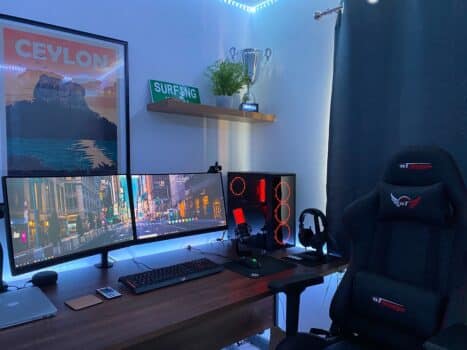Do you want to upgrade your boring old PC setup, but do not know how? Well, that’s when a dual monitor stand can come to your aid.
A dual monitor stand will allow you to set up not one, but two monitors for your PC. So, you get double the screen space which is great for multitasking, gaming, or any form of graphical designing.
Yeah, we understand that many of you might be a little skeptical in this regard. After all, getting such a setup can be quite an investment for an average user. But believe us, you won’t be disappointed.
That said, if you do not know how to set up a dual monitor stand, it’s pretty simple. All you need to do is mount the monitors on the docking plates of a dual stand.
We have described the process in detail below, so if you are interested, then keep reading!
Choosing The Monitors

Selecting the monitors is the very first step that you need to take for setting up a dual monitor arrangement. You will need to consider different aspects of the screen, such as the brand, size, compatibility, and so on.
Make sure that both the display panels meet VESA measurement standards. Also, for consistency, we would suggest that you ensure that the size and brand of both monitors are the same. This is not a mandatory aspect, and you can opt for different brands and sizes as per your budget. But in that case, you may need to deal with some compatibility issues.
Selecting The Dual Monitor Stand
In terms of design, most dual monitor stands come in two forms. One of the forms follows a simple static design, while the other form features articulating monitor arms that are highly adjustable.
Most importantly, you should make sure that the stand allows you to tilt, swivel, or make rotational adjustments to the dual monitors freely. What it essentially means is that the stand should be ergonomic enough to ensure better posture and prevent a stiff back and neck.
Setting Up Your Dual Monitor Stand
Before setting up the stand, you should consider the table or desk you are using. It should have enough desk space to accommodate the stand, as well as any other components that you may need.
The material of the desk also needs to be considered here. Ideally, we would recommend any material apart from glass since it can break easily under heavy weight. However, if you have no other option, you can use a separate desk mount over the glass table to prevent it from cracking.
For uniformity, all dual monitor stands come with a VESA mount mechanism. It includes a removable structure known as a VESA plate that is found on both monitor arms. So, you can mount the two screens individually to these plates to proceed with the setup process.
In some models, you can simply attach the monitor panel to the removable VESA plates, and they will automatically snap in place. For other stands, the detachable VESA plates need to be tightened with a screwdriver so that they hold the screen securely.
After the displays have been mounted, you will need to take care of the cables. Most dual monitor stands come with integrated cable management features to arrange or hide the cables from view and keep your workstation clutter-free. These include cable slots, clips, and channels through which you can run the cables.
In order to finish setting up the stand, some adjustments need to be made based on the aspects described below.
A. Positioning
Correctly positioning the monitors is a crucial aspect since this will affect how you use your computer. You should adjust the dual monitor arms to bring the monitors closer together.
Likewise, swivel and rotate the monitor arm for the main screen and the secondary screen individually. That will allow you to orient the screens as per your liking. For instance, for vertical applications, you might need to rotate the screens by 90 degrees.
B. Level
You should always keep the monitors at eye level in order to prevent eye strain. Keeping the two monitors at that level will also minimize neck strain, reduce glare, and provide you with the best visibility of the things on the screen space.
In that context, you can adjust the height of the stand to bring it up to your eye level. Typically, the height is easily adjustable with the help of a lever or another similar mechanism. You can also tilt them to any given angle as supported by the stand to better adjust the monitors to your eyes.
C. Distance
For making the setup ergonomic, the viewing distance of the monitors needs to be considered too. Clamp the dual monitor stand at such a spot on your table that it provides you with a comfortable viewing distance.
Setting Up The Dual Monitors
Once you have the dual monitor mount in place, you will need to set them up for use. For this purpose, you will need to connect the monitors to the suitable display ports and adjust the settings on your computer.
1. Connecting To The Ports
First, make sure to plug the monitor to a suitable power source. Then connect the cables to the relevant ports on your computer case. You can usually find these ports on the back of the case.
2. Updating The Settings
Once the monitors have been connected to the display ports, you will need to update the settings. You can do this via the system settings of your operating system. Alternatively, the monitors can be set up through the GPU control panel as well, provided your computer uses a dedicated graphics card.
If you notice any issues with the setup, you might need to update the graphics drivers. Also, make sure that the cables are firmly secured to the ports. After you calibrate the displays, your dual computer monitor arrangement will be ready for use.
Factors To Consider When Setting Up Your Dual Monitors
You need to keep certain things in mind when setting up two computer monitors. These will ensure that you don’t have any problems during or after the setup.
1. Weight Capacity Of The Stand
Every dual monitor stand has a maximum load capacity that is generally mentioned in the documentation or product info. If the weight of the two monitors exceeds this capacity, the stand becomes unstable.
So, ensure that the cumulative weight of both monitors does not exceed the maximum weight limit of the stand. You could also try getting a stand that has a higher load capacity so that you won’t need to worry about this issue.
2. Desktop Space
When setting up the monitors, you need to keep in mind the desk space that you have available. Surely, you wouldn’t want to be in a situation where most of the desk is occupied by the screens alone, right? That would not leave any room for keeping any other necessary items in your workspace.
Luckily, most dual monitor stands today have a very small footprint so that you have sufficient space on your desk. You can also opt for wall-mounted stands that will eliminate the need for a desk altogether.
Another way to get around this issue is to get a large enough desk for your dual monitor stand. That way, you won’t have to worry about space issues at all.
3. GPU Compatibility
If you want to use a dual monitor setup, then you need to make sure that your GPU is compatible with the same. In this regard, you will be relieved to know that most modern GPUs by Nvidia, AMD, and Intel support dual monitor arrangements.
However, if your computer is relatively old or has an integrated graphics card instead of a dedicated one, you might have some trouble setting up dual monitors. In such a scenario, we advise you to check the documentation of your PC or GPU for better clarity.
How To Set Up Dual Monitor Stand Frequently Asked Questions ?
Can you use more than two monitors on a dual stand?
If you are wondering about how to add a third monitor to a dual stand, then you can do it with the help of an additional docking station. Since a dual stand has only two arms, this docking arm will need to be attached separately.
However, we would not recommend doing this since it might exceed the maximum load limit of the stand. If you want three monitors, you can get a suitable stand that has three arms.
Can you use dual monitors with a laptop?
Yes, you can use a dual monitor setup with a laptop as well. Most laptops come with an HDMI and USB port, both of which can be used to attach the two external monitors.
In order to connect the monitors with the HDMI, you can use an HDMI splitter. If you’re going to use the USB port, we suggest using a USB dongle with an HDMI interface.
Can you make a DIY dual monitor stand?
Provided you have the right materials and tools, you can easily make a DIY dual monitor stand. The primary materials that you will need are PVC pipes, elbow joints, metal clamps, end caps, and a wood batten, along with screws, screwdrivers, and so on.

How To Set Up Dual Monitor Stand Final Words
There is a reason why most hardcore gamers, designers, and computer enthusiasts swear by dual monitor setups. With the level of immersion they provide, you will forget about using single monitors.
So, if you even remotely consider yourself to be a computer geek, then you should definitely give it a try. If you like the experience, you could even go for a triple, or quadruple monitor setup, provided your GPU supports it.
With the information we have provided here, you can set up your monitors without a hitch!
Want to know more DIY articles like this? Checkout our next article on how to read a digital caliper for accurate measurement without the need of any professionals.


